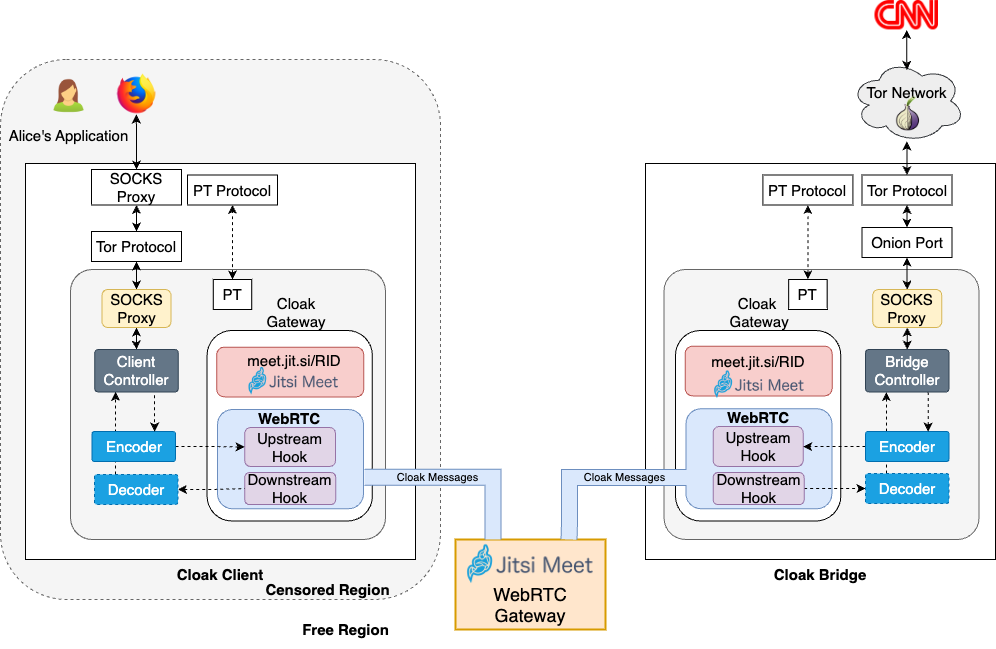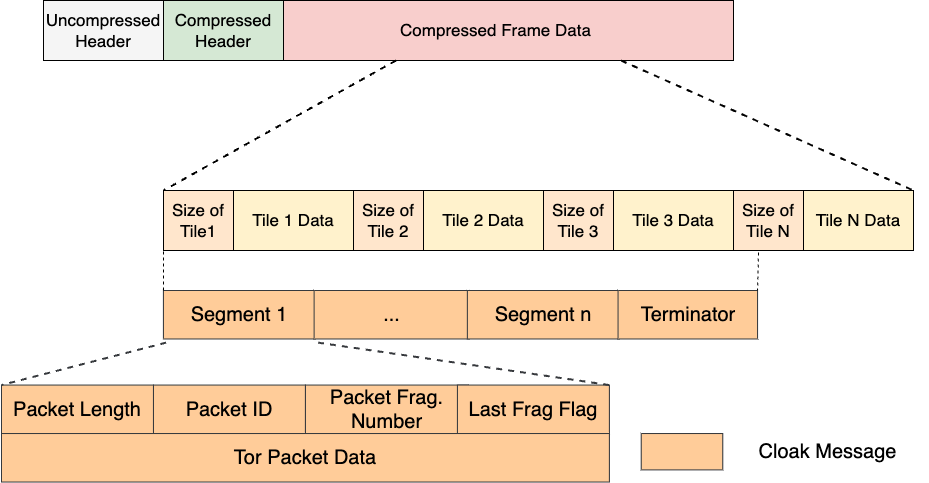System Features
Carrier Media
Cloak utilizes WebRTC (Web Real-Time Communication) as a carrier medium for Tor traffic, providing a covert channel to bypass censorship and ensure secure communication. WebRTC is a powerful framework commonly used in real-time video conferencing applications, and Cloak leverages its features to create an inconspicuous tunnel for Tor traffic.
The process begins with the Cloak client. When a user initiates a Tor connection, the Cloak client intercepts the traffic and encodes it into video frames using the Protozoa encoders.
These video frames, containing the Tor traffic, are then sent through the video stream of a carrier WebRTC-based application, such as Jitsi Meet. The carrier application, unaware of the hidden Tor traffic, treats it as regular video data, making it indistinguishable from a typical video call.
At the other end of the tunnel, a Cloak bridge receives the video frames and decodes the embedded Tor traffic. The bridge routes this data to a Tor relay, allowing it to proceed through the Tor network and reach its intended destination securely and anonymously.
By adopting this approach, Cloak effectively camouflages Tor traffic within the guise of innocuous video calls, rendering it highly resistant to traffic analysis attacks.
Rendezvous Addresses Protocol
To address the challenges in managing bridge addresses and membership, Cloak proposes a comprehensive solution that ensures secure and anonymous sharing of rendezvous chatroom IDs with individual users. The system utilizes an out-of-band channel to transmit RIDs, employing applications not based on Tor to avoid detection by adversaries. Carrier applications are carefully chosen to establish secure and encrypted end-to-end connections, offering robust resilience against blockage attempts.
Cloak adopts a structure similar to Snowflake’s proxy dissemination mechanism and introduces a dedicated component called the broker. The broker’s role is to connect Cloak clients with available bridges through a simple API. Clients share their intended RIDs along with corresponding passwords, and the broker facilitates the connection to an available bridge, allowing both parties to initiate a WebRTC-based video call.
The rotation of chatroom RIDs is essential to enhance resistance against censorship. Cloak addresses this by generating unique RIDs per session per user. After the video call session is terminated, a new RID is generated and shared for subsequent sessions. This dynamic approach minimizes the risk of detection by censors, as long-term or shared RIDs would be more vulnerable to discovery.
To establish trust between clients and bridges, Cloak bridges advertise their public key certificates to the broker. Clients can download and verify these certificates to authenticate the chosen bridge before establishing a covert session, effectively solving the challenge of bridge authentication.
Frame Encoding and Decoding Protocol
Cloak employs a covert frame encoding and decoding mechanism that operates within the WebRTC framework, specifically integrated into the Chromium Browser. This approach replaces certain bits of the encoded video signal after the video encoding engine processes it. To achieve this, the WebRTC Protozoa stack incorporates two essential hooks for intercepting media streaming in different directions: upstream and downstream.
Upstream Hook
The upstream hook intercepts outgoing frame data from a local camera device to the network.
It is strategically placed after the raw video signal undergoes processing by the video engine but before the frame data is handed over to the transport layer to create Secure Real-time Transport Protocol (SRTP) packets for network transmission.
Downstream Hook
The downstream hook intercepts incoming frame data from the network to the local screen.
Positioned right after the transport layer reconstructs an encoded frame, which is transmitted in multiple network packets, but before it is delivered to the video engine for decoding and rendering on the screen.

The core data structure employed for encoding and decoding is known as the Encoded Frame Bitstream (EFB). This structure, utilized by Protozoa as well, includes a header and partitions dedicated solely to storing encoded video bytes. It effectively segregates the zones where data can be encoded without disrupting the video stream’s functionality or leading to losses. The EFB’s design ensures that once generated by the video encoding engine, it remains unmodified, undergoing encryption and authentication measures before being assembled into packets. As a result, it provides an ideal location for embedding covert data without interfering with the application, maintaining encryption and authentication integrity.
It is essential to exercise caution while manipulating the EFB, as uncontrolled corruption may lead to issues with video decoding at the receiver’s end, affecting the WebRTC downstream pipeline. The presence of corrupted frame data may trigger congestion control mechanisms, such as the Picture Loss Indication (PLI), within the accompanying RTCP control channel. The PLI requests the re-transmission of a key frame in case of decoding difficulties. Such congestion control mechanisms could severely reduce channel bandwidth and inadvertently expose Cloak to traffic analysis.
To circumvent this problem, the downstream hook employs a pre-recorded sequence of valid encoded frames to feed the WebRTC video decoder. By replacing corrupted frames received over the network with pre-recorded ones, Cloak establishes a covert channel without triggering any frame corruption control mechanisms. This ensures that the channel bandwidth and traffic patterns remain intact and resilient to traffic analysis.
In summary, the encoding and decoding strategy employed by Cloak is codec and data structure agnostic. This flexibility enables the encoding of various types of data into video frames, allowing us to effectively replace bytes that, under normal circumstances, represent video frame data with Tor traffic data.
Cell Packet Format
As Cloak adapted to newer WebRTC-based videocall applications using the VP9 video codec, adjustments were made to Protozoa’s Encoded Frame Bitstreams (EFBs). The main difference between VP8 and VP9 codecs lies in VP9’s additional compressed header alongside the pre-existing uncompressed header.
To ensure frame integrity and prevent corruption, the offsets were recalculated to account for the new header. By leveraging the VP9 Decoding Specification and WebRTC’s VP9 decoding structure, the EFBs were modified to replace carrier video bits with covert data while preserving the header structure for seamless decoding.

WebRTC’s encoded_frame.h structure was also enhanced to include information about the codec used to encode the frame. This enables dynamic adaptation to support multiple video codecs during runtime.
It was observed that VP9 encoded frames significantly differed from VP8 frames, triggering frame corruption control mechanisms when using the wrong frames. To overcome this, a new sequence of valid encoded frames specifically for VP9 was recorded, and dynamic switching of pre-recorded frames during runtime was implemented based on the codec used for a particular session.